Healing Leadership: The Impact of Childhood Trauma on Executive Decision-Making

Unresolved childhood trauma can significantly impact leadership styles, decision-making processes, and business performance. This article explores how these influences manifest and offers strategies for executives to recognize and address them for more effective and compassionate leadership.
The influence of childhood experiences extends well beyond early life, shaping how we respond to stress, interact with others, and lead in adulthood. For executives and CEOs, unresolved childhood trauma can profoundly affect their leadership style and decision-making abilities, often leading to challenges in business performance and workplace culture.
Statistics from the Centres for Disease Control and Prevention (CDC) underscores the widespread impact of adverse childhood experiences (ACEs) on the adult population. Specifically, 61% of adults report having experienced at least one ACE, such as abuse, neglect, or household dysfunction, while 16% report having experienced four or more. Given this high prevalence, it’s highly likely that many executives and leaders are among those affected, carrying the emotional and psychological scars of these early traumas into their professional lives.
These unresolved experiences can manifest in various ways, influencing how leaders manage stress, build relationships, and make decisions. For instance, executives who experienced ACEs may be more prone to high-functioning behaviours like perfectionism or overachievement as coping mechanisms. Alternatively, they may struggle with emotional regulation, trust, or collaboration – critical skills in leadership roles.
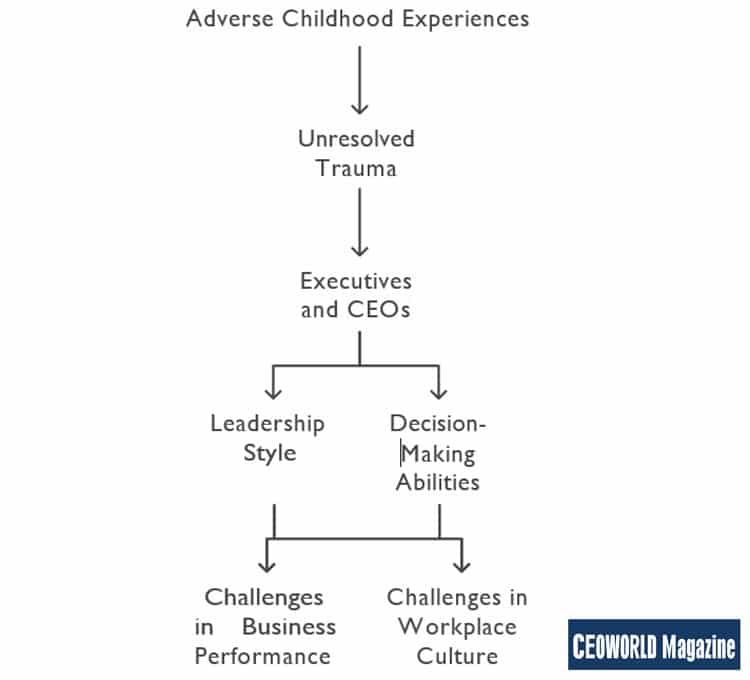
The Link Between Childhood Trauma and Leadership Styles
- The High-Functioning Trauma Response: One of the most common manifestations of childhood trauma in leaders is the high-functioning trauma response. Many successful executives may appear calm, composed, and efficient, but underneath, they may be driven by fear, insecurity, or an intense need for control – traits that can stem from adverse childhood experiences. Studies show that childhood trauma can lead to behaviors such as perfectionism and overachievement, often seen as strengths in the business world. These behaviors can mask unresolved trauma, pushing leaders to work excessively or micromanage teams, ultimately hindering their effectiveness.
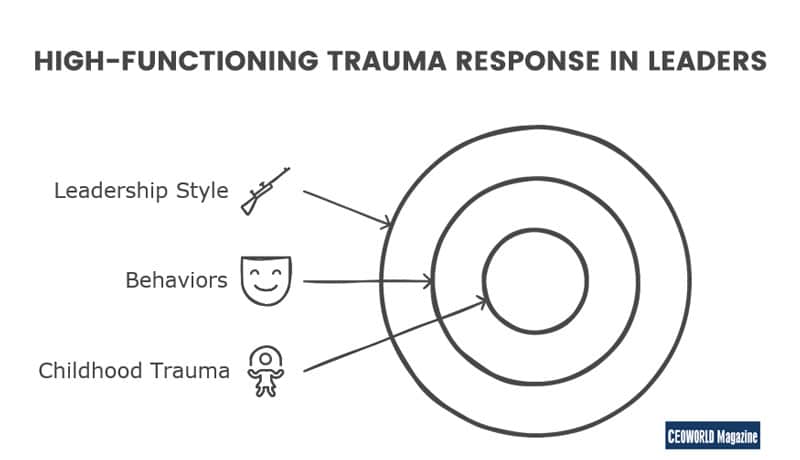
- Emotional Reactivity and Decision-Making: Trauma can alter the brain’s stress response systems, leading to emotional reactivity. Research indicates that individuals with unresolved childhood trauma may have an exaggerated response to perceived threats, making them more prone to anxiety, anger, or impulsive decision-making. For CEOs, this can result in poor judgment, especially in high-stakes situations. Decisions made out of fear or anger often lack the strategic foresight required to navigate complex business environments.
A study by Harvard Business Review found that 43% of executives report feeling overwhelmed by stress, impacting their clarity and focus. For those with unresolved trauma, stress levels can be amplified, impairing their ability to assess risks and opportunities objectively.
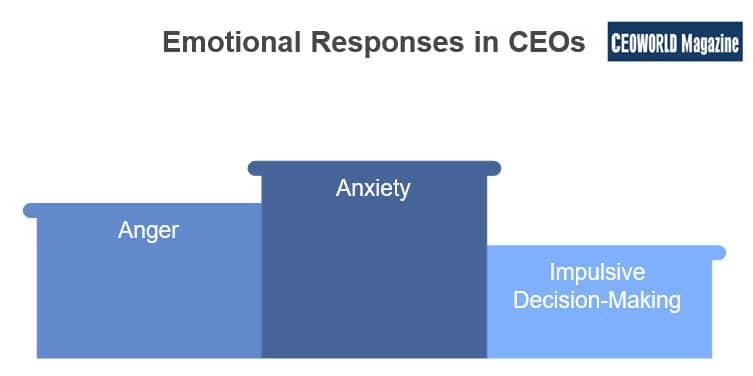
- Attachment Styles and Workplace Relationships: Childhood trauma can also affect how leaders form relationships. Attachment theory suggests that early experiences with caregivers shape our ability to connect with others as adults. Leaders with insecure attachment styles (stemming from childhood trauma) may struggle with trust and may either avoid close relationships (dismissive-avoidant) or become overly dependent on others (anxious-preoccupied).
According to research published in the Journal of Business Psychology, leaders with insecure attachment styles often struggle with delegation, feedback acceptance, and collaborative decision-making. These difficulties can create tension with reduced employee morale, and diminish organizational cohesion.
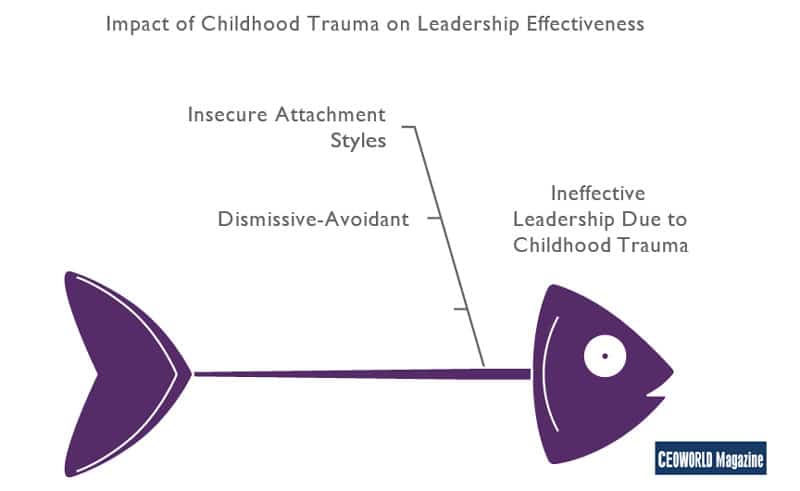
How Unresolved Trauma Impacts Business Performance
- Burnout and High Turnover Rates: Leaders dealing with unresolved trauma often push themselves and their teams to extremes, leading to burnout. A report by Deloitte found that 77% of employees have experienced burnout at their current jobs, and poor leadership is a significant contributing factor. Leaders who operate from a place of unresolved trauma set unrealistic expectations, fail to provide adequate support, and maintain rigid control, creating an environment where employees feel stressed and undervalued.
High turnover rates are another consequence. When leaders struggle with trust and control issues rooted in trauma, they may micromanage or fail to create a psychologically safe workplace. A Gallup poll found that 50% of employees left their jobs to escape bad managers rather than leaving the company itself. For businesses, this constant turnover leads to higher recruitment costs, lost productivity, and a decline in overall team performance.
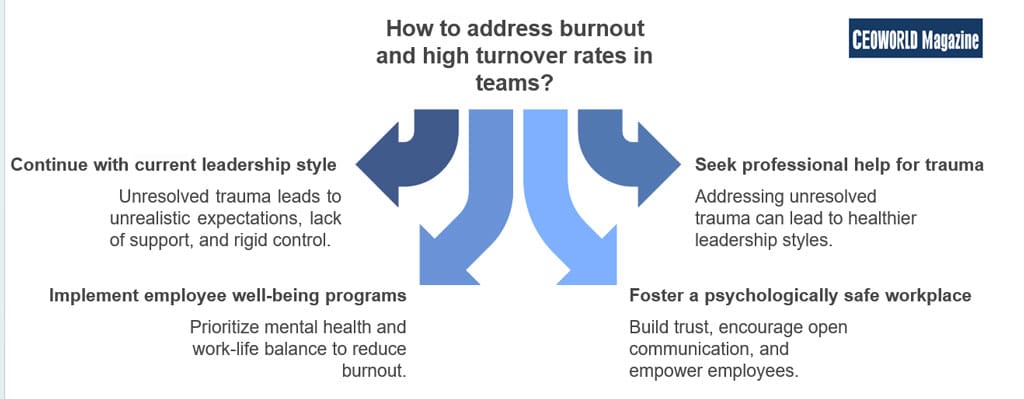
- Reduced Innovation and Strategic Agility: Unresolved trauma can make leaders risk-averse, as their decision-making processes are often shaped by a desire to avoid negative outcomes rather than to pursue new opportunities. A study published in the Journal of Management highlighted that executives with unresolved trauma histories were more likely to choose short-term, risk-averse strategies over innovative, long-term solutions. This tendency can limit a company’s potential for growth and adaptation, especially in rapidly changing industries.
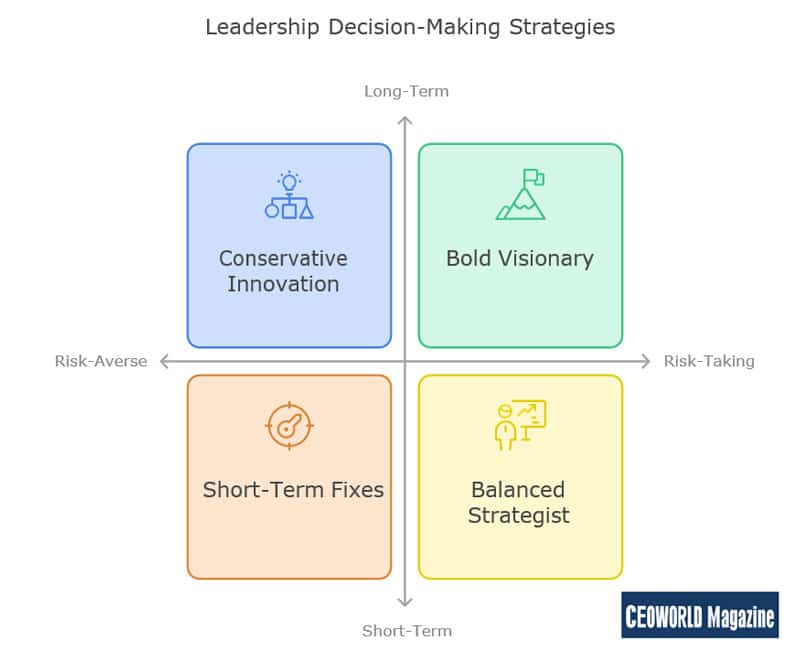
- Negative Impact on Corporate Culture: When executives operate from a place of trauma, they may inadvertently create toxic work cultures. Leaders who struggle with emotional regulation and trust may resort to authoritarian or punitive management styles, leading to an atmosphere of fear and anxiety among employees. According to a survey by the Society for Human Resource Management (SHRM), 58% of employees say they left their job due to a negative or toxic workplace culture. This statistic emphasizes the profound influence of leadership on organizational and the critical importance of trauma-informed leadership.

Strategies for Leaders to Address Childhood Trauma
Recognizing and addressing childhood trauma is not only essential for personal well-being but also for effective leadership. By adopting specific strategies, executives can transform their leadership style, improving both business performance and workplace culture.
- Self-Awareness and Therapy: The first step toward healing is recognizing the impact of trauma on one’s leadership style. Therapy, particularly trauma-focused cognitive behavioral therapy (TF-CBT) and eye movement desensitization and reprocessing (EMDR), has been shown to be effective in helping individuals process trauma and develop healthier emotional regulation skills. Investing time in therapy allows executives to gain insight into how their past influences their behaviors and decision-making processes.
- Mindfulness and Emotional Regulation Techniques: Mindfulness practices, such as meditation and breathing exercises, can help leaders manage stress and emotional reactivity. A study by Harvard Business Review found that executives who practiced mindfulness reported a 31% reduction in stress levels and a 15% improvement in decision-making clarity. Regular mindfulness practice allows leaders to pause, reflect, and respond thoughtfully.
- Leadership Coaching with a Trauma-Informed Approach: Traditional leadership coaching may not address the root causes of behavior, but trauma-informed leadership coaching offers a deeper level of insight. Such coaching focuses on helping executives understand how their past experiences shape their professional habits and decisions. It also equips them with strategies to lead with empathy, authenticity, and emotional intelligence – traits that are increasingly valued in today’s business landscape.
- Creating a Supportive Corporate Environment: Executives who prioritize their own healing can also create more supportive environments for their teams. By fostering a trauma-informed culture that emphasizes psychological safety, open communication, and work-life balance, leaders can enhance employee engagement and productivity. According to Gallup, companies that prioritize employee well-being see a 21% increase in profitability and a 41% reduction in absenteeism.

- Investing in Professional Development Programs: Organizations can support executives by offering personal development programs that focus on emotional intelligence, resilience, and trauma awareness. Such programs not only benefit leaders but also trickle down to positively impact the entire company culture. According to the Journal of Organizational Behavior, companies that invest in leadership development focusing on emotional and psychological growth see a 26% improvement in overall business performance.
Conclusion
Unresolved childhood trauma has a profound impact on leadership styles, decision-making processes, and performance. By recognizing these patterns and actively working through them, executives can transform their leadership approach, creating healthier, more effective workplaces. Investing in therapy, mindfulness practices, trauma-informed coaching, and supportive corporate environments not only benefits individual leaders but also contributes to a more resilient and innovative organization. In the evolving business world, healing leadership is not just a personal journey; it is a strategic advantage.
Written by Anu Verma.
Have you read?
World’s Most Innovative Countries, Best Fashion Schools. Best Universities. Best Medical Schools. Best International High Schools. Countries: Most Female Billionaires.
Bring the best of the CEOWORLD magazine's global journalism to audiences in the United States and around the world. - Add CEOWORLD magazine to your Google News feed.
Follow CEOWORLD magazine headlines on: Google News, LinkedIn, Twitter, and Facebook.
Copyright 2025 The CEOWORLD magazine. All rights reserved. This material (and any extract from it) must not be copied, redistributed or placed on any website, without CEOWORLD magazine' prior written consent. For media queries, please contact: info@ceoworld.biz








